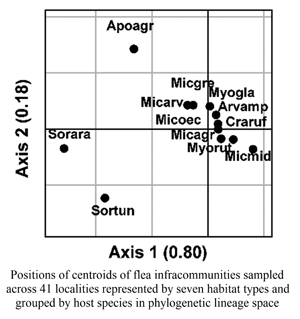Article contents
Spatial and temporal variation of compositional, functional, and phylogenetic diversity in ectoparasite infracommunities harboured by small mammals
Published online by Cambridge University Press: 15 February 2021
Abstract

We studied patterns of compositional, functional, and phylogenetic α- and β-diversity in flea and gamasid mite infracommunities of small Siberian mammals, taking into account host-associated (species) and environmental (biome or sampling period) factors. We asked: (a) How do these factors and their interactions affect infracommunity diversity? (b) Does infracommunity composition, in terms of species, traits, and phylogenetic lineages, deviate from random? (c) Are species, traits, and phylogenetic lineages in infracommunities clustered or overdispersed?, and (d) Do patterns of diversity differ between the three diversity facets and/or the two ectoparasite taxa? We found that the α-diversity of infracommunities was strongly affected by host species, biome, and sampling period. The highest proportion of infracommunity diversity in both taxa was associated with the interaction between either host species and biome or host species and sampling period. Infracommunities of both taxa within, as well as between, host species, biomes, and sampling periods were characterized by the clustering of species, traits and lineages. The patterns of the effects of host species, biome, and sampling period on infracommunity diversity were congruent among the three diversity facets in both fleas and mites. We conclude that the assembly patterns in ectoparasite infracommunities mirror those characteristics of component and compound communities.
- Type
- Research Article
- Information
- Copyright
- Copyright © The Author(s), 2021. Published by Cambridge University Press
References
- 2
- Cited by



